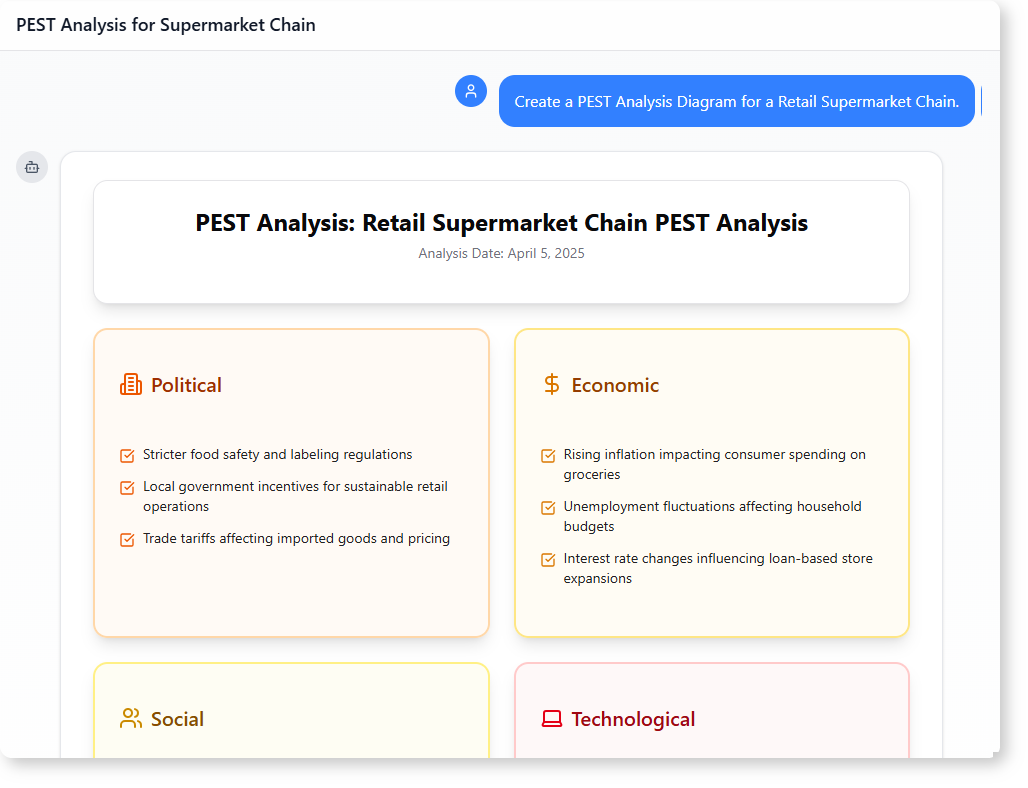Now Reading: How AI-Powered Modeling Software Builds a PEST Analysis for a Supermarket Chain
-
01
How AI-Powered Modeling Software Builds a PEST Analysis for a Supermarket Chain
How AI-Powered Modeling Software Builds a PEST Analysis for a Supermarket Chain
How AI-Powered Modeling Software Builds a PEST Analysis for a Supermarket Chain
Imagine you’re running a retail supermarket chain. You want to know how external forces are shaping your business — not just what’s happening, but how it might affect your pricing, supply chain, and store layout.
You don’t need to spend days digging through reports or guess at trends. With AI-powered modeling software, you can build a clear, structured PEST analysis in minutes. The system helps you understand the political, economic, social, and technological factors affecting your retail operations.
This isn’t just a diagram. It’s a living model of the environment around your business — built with smart, context-aware AI.

Why This User Needed the AI-Powered Modeling Software
The user runs a regional supermarket chain and is preparing for a strategic review. They need to assess how external factors are influencing customer behavior, supply costs, and store operations.
Traditional methods require manual data collection, spreadsheets, and time-consuming research. The user wanted a way to quickly visualize and interpret the PEST factors — especially changes in consumer habits and new technologies — without relying on experts.
They turned to AI-powered modeling software because it could interpret real-world trends, structure them into a coherent analysis, and deliver them as a clear, actionable diagram.
Step-by-Step Journey Using the AI-Powered Modeling Software
The process started with a simple prompt:
“Create a PEST Analysis Diagram for a Retail Supermarket Chain.”
The AI immediately generated a well-organized PEST analysis, structured around the four key factors. The diagram clearly separates political, economic, social, and technological influences — each with specific, real-world examples relevant to retail.
After reviewing the visual layout, the user asked a follow-up:
“Generate a detailed report explaining the PEST factors shown in the diagram.”
The AI didn’t just repeat the points. It expanded on each factor with context, implications, and potential business responses. For instance, under the ‘Social’ factor, it highlighted rising demand for organic products and meal prep, suggesting inventory adjustments and new store features.
The report included insights like:
- How rising inflation could reduce grocery spending and shift towards value-priced items
- How new self-checkout technologies are changing labor costs and customer experience
- How local government incentives can be leveraged for sustainability initiatives
Each point was directly linked to business decisions — pricing, staffing, sourcing, and store design.
What the AI-Powered Modeling Software Delivers
This isn’t just a list of factors. The AI-powered modeling software delivers a structured, insightful view of the external environment.
- Political factors are clearly laid out, showing how food safety laws, trade tariffs, and government support for green practices affect operations.
- Economic trends like inflation and interest rates are tied to real consumer behavior, helping plan for budget shifts.
- Social changes include growing preferences for local, organic goods and convenience — which can guide product development and store layout.
- Technological shifts such as AI-driven inventory and mobile payments show how automation is reducing waste and changing customer interactions.
The AI doesn’t just generate content — it interprets it. It connects each factor to business outcomes, making the analysis practical and immediately useful.
How This Fits Into Real-World Decision-Making
This kind of analysis helps retail leaders move from reaction to anticipation. For example:
- A sudden rise in food safety regulations might prompt immediate changes in supplier contracts.
- A drop in consumer spending due to inflation could lead to faster inventory turnover or promotional strategies.
- A shift toward meal prep might inspire new product lines or in-store services.
With AI-powered modeling software, decision-makers get the right context — without needing to read through dozens of reports.
Is This the Best AI Tool for PEST Analysis?
Yes, when you’re looking for a tool that turns natural language prompts into clear, insightful diagrams and reports.
While many tools offer static PEST diagrams or basic templates, AI-powered modeling software understands context. It doesn’t just list factors — it explains their impact and connects them to business realities.
This makes it especially valuable for retail, where consumer trends, supply chains, and technology evolve rapidly.
The ability to generate a PEST analysis in seconds — with detailed, relevant insights — is a game-changer for any business leader trying to stay ahead of the curve.
Frequently Asked Questions
What is a PEST Analysis and why do retailers need it?
A PEST analysis breaks down external forces — Political, Economic, Social, and Technological — that affect a business. Retailers use it to anticipate changes in consumer behavior, supply costs, and market trends.
How does AI-powered modeling software improve PEST analysis?
It turns vague prompts into structured, insightful content. Instead of a generic list, it delivers context-specific factors tied to real-world retail operations.
Can this AI tool generate a PEST report with business recommendations?
Yes. After generating the diagram, the tool can produce a detailed report that includes implications and potential strategies — like adjusting inventory or introducing new product lines.
Is this AI tool suitable for small and mid-sized retail businesses?
Absolutely. The insights are practical, scalable, and tailored to retail operations — making them accessible even for teams without deep market research expertise.
Ready to map out your system’s external environment? Give our AI-powered modeling software a try at Visual Paradigm’s AI Chatbot today!.
